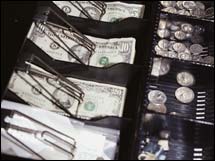|
Consumers hold on to their dollars Personal spending posts disappointing rise, despite jump in income, lower gasoline prices. NEW YORK (CNNMoney.com) -- Increased pay and falling gas prices helped put more money into consumers' pockets in September, but they didn't rush to stores to spend that money, according to a government report Monday. Spending by consumers rose just 0.1 percent in September, the Commerce Department reported, after a revised 0.2 percent rise in August. Economists surveyed by Briefing.com had looked for a 0.3 percent increase.
Personal income jumped 0.5 percent, after a 0.4 percent rise in August. Economists had also looked for a 0.3 percent rise there. Part of the drop in spending was due to lower prices for energy. Spending when adjusted for inflation was up 0.4 percent, which Mark Vitner, senior economist with Wachovia, described as healthy. "It's only weak because of big drop in gas prices that we had the lower-than-expected spending," he said. "This should dispense with some of the worst fears that consumers are going to shut down and stop spending because of the slump in housing." Prices paid by consumers, measured by the personal consumption expenditure index, an inflation gauge watched closely by policy makers, fell 0.3 percent, due mostly to lower energy prices. The more closely watched core PCE, which excludes food and energy prices, rose 0.2 percent after rising 0.3 percent in August. Compared to a year ago, the core PCE is up 2.4 percent versus a 2.5 percent year-over-year rise in August. That's closer to the Federal Reserve's stated 1 to 2 percent comfort zone for the PCE, raising expectations that the central bank will holed interest rates steady for now. Despite the declining inflation reading, Fed governor Andrew Lacker gave a speech Monday in which he characterized inflation as still being "discomforting." Lacker is the lone Fed policymaker to vote for rate hikes at the last three meetings. But some economists said that despite Lacker's comments, the Fed can live with inflation at the levels seen in Monday's report. "My hunch is the Fed more comfortable with the core PCE (reading) than they've let on," said Vitner. The report comes after news Friday that third-quarter erconomic grwoth was the weakest in three years. Some other economists said it appears that consumers will be somewhat cautious about spending heading into the all-important holiday shopping period, even with lower prices and improving wages. Gus Faucher, director of macroeconomics for Moody's Economy.com, said he considered Monday's report to be "mildly positive" given it showed inflation pressures lessening. "We're still going to see growth in spending and it should be a decent holiday season, but not a blockbuster one," he said. Wal-Mart Stores (Charts), the No. 1 retailer, has been plagued by weak sales recently. Saturday it reported sales at U.S. stores open at least a year rose a disappointing 0.5 percent in October, following a 1.3 percent gain in September. Other major retailers report October sales Thursday, and as a group they reported strong September numbers. Even with the improved income and the drop in prices, U.S. consumers were spending more than they were taking in last month. The report said that for every $100 in after-tax income, Americans spent $100.20. But that's an improvement from the even higher negative savings rates in the other monthly reports this year. "Even if it puts a curb on spending, that's a positive in the long run," said Faucher. "They need to improve their personal balance sheets." Spending on big ticket items, such as autos, were one of the things helping support spending in September. Reports from the automakers show that overall new vehicle purchases rose in the month, even though General Motors (Charts) and the Chrysler Group of DaimlerChrysler (Charts) both reported drop in sales from a year earlier, while Ford Motor (Charts) posted a gain. U.S. sales soared at Toyota Motor (Charts) even as gas prices retreated. Economy weakest in three years Correction: An earlier version of this story said spending fell when it rose. CNNMoney.com regrets the error. |
|

